 We are in the midst of a season of celebration and food is one of the primary ways we celebrate. Memories and emotions linked are linked to our holiday foods. Unfortunately, most of these foods are no longer grandma’s apple pie baked from scratch and fresh ingredients. They are easy prep foods out of boxes or pre bought from stores. Even the homemade ones are centered on highly refined white flours, sugars and suspect cooking oils. This year, I invite you to create new food memories centered on delicious, nutrient dense meals and this certainly includes desserts! To this end, I am sharing with you two wonderful and low drama dessert recipes: Baked Apple Chunks with Nuts and Decadent Pumpkin “Pudding” Cups. Baked Apple Chunks are not nearly as boring as they sound, but they are super simple. I have adapted the recipe from Internal Bliss, a cookbook full of recipes designed for the GAPS diet (more about this shortly). The second recipe is a “pudding” in the old fashioned sense, so erase images of Jell-O instant out of your head; it is sophisticated and delicious. This recipe is one of my own, designed several years ago to meet a gluten-free, dairy free, rich, creamy, Thanksgiving dessert need. By low drama, I mean that these desserts will be gentle on blood sugar and your body’s state of balance; they will be high drama in terms of flavor and satisfaction. In addition to being gluten-free and dairy free, both dishes are completely grain grain-free and made using complex carbohydrates from fruits and vegetable, healthy fats and worthwhile sources of sugar.
We are in the midst of a season of celebration and food is one of the primary ways we celebrate. Memories and emotions linked are linked to our holiday foods. Unfortunately, most of these foods are no longer grandma’s apple pie baked from scratch and fresh ingredients. They are easy prep foods out of boxes or pre bought from stores. Even the homemade ones are centered on highly refined white flours, sugars and suspect cooking oils. This year, I invite you to create new food memories centered on delicious, nutrient dense meals and this certainly includes desserts! To this end, I am sharing with you two wonderful and low drama dessert recipes: Baked Apple Chunks with Nuts and Decadent Pumpkin “Pudding” Cups. Baked Apple Chunks are not nearly as boring as they sound, but they are super simple. I have adapted the recipe from Internal Bliss, a cookbook full of recipes designed for the GAPS diet (more about this shortly). The second recipe is a “pudding” in the old fashioned sense, so erase images of Jell-O instant out of your head; it is sophisticated and delicious. This recipe is one of my own, designed several years ago to meet a gluten-free, dairy free, rich, creamy, Thanksgiving dessert need. By low drama, I mean that these desserts will be gentle on blood sugar and your body’s state of balance; they will be high drama in terms of flavor and satisfaction. In addition to being gluten-free and dairy free, both dishes are completely grain grain-free and made using complex carbohydrates from fruits and vegetable, healthy fats and worthwhile sources of sugar.
In the context of sharing these recipes, I’ll also be discussing blood sugar, the merits of one type of sugar vs. another, and some thoughts on fat and oil choices for cooking. Read on, enjoy, and feel inspired to give your loved ones the gift of healthy foods this year.
Apple Chunks with Nuts:
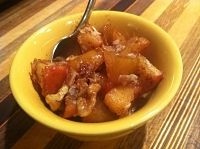 There are hardly any simpler from-scratch recipes than this. It takes just a few minutes to prep and the rest of the time is for baking.
There are hardly any simpler from-scratch recipes than this. It takes just a few minutes to prep and the rest of the time is for baking.
Baked fruits, such as apples and pears, naturally become sweeter as they are cooked, which means very little additional sweetener is needed. This recipe calls for honey and the following recipe calls for maple syrup. Why not plain old white sugar?
White Sugar vs. Honey: Although I prefer cane sugars to high fructose corn syrup and to artificial sweeteners such as equal, NutraSweet and even Splenda, it lacks nutrients and can play havoc on blood sugar. I think of refined white flour and refined white sugar in the same category because both require your body to expend nutrients to digest them while not contributing any. In other words, they are NEGATIVE nutrition, empty calories. Additionally, they hit the blood stream very quickly and can cause nervous energy with a quick crash afterwards. Over reliance on these foods can lead to nutrient deficiencies, blood sugar issues including both low blood sugar/hyperglycemia and diabetes, as well as weight gain, cravings and depressed moods. Fortunately, there are sweeteners that can provide nutrients to your body as well as sweetness for your tooth. Honey and maple syrup both fall into this category. Maple syrup is rich in trace minerals. Real grade B maple syrup is the unrefined variety and this is what you want; make sure your source is formaldehyde-free, many commercial varieties are not. Medicinally, local honey can be used as part of a treatment plan for allergy sufferers, to aid in wound healing and healing sore throats. Although the honey in this recipe is cooked with the apples, raw honey is full of live enzymes that are highly beneficial to the body; because of this bonus, it is one of my favorite sweeteners to use in recipes that do not require heating. There is an extensive discussion of honey’s merits. This link includes a discussion of several small studies suggesting that honey has positive effects on cholesterol and other inflammatory blood markers as well as blood sugar levels. Why not make it your sweetener of choice?
In Moderation: Even healthy natural sugars need to be used in moderation. It is also best to have any form of sugar with fiber and a healthy fat so that the potential for negative effects is minimized. Fiber and fat causes sugar to be released more slowly into the blood stream, which means less drama for your body. When sugar hits the blood stream quickly and all at once the body gets a spike of energy and then crashes. The way this feels for each individual can be a little different—feeling sleepy or fatigued; feeling “wired” before crashing; feeling cranky, shaky, light headed or dizzy. For some, the effects are less noticeable but will still have long-term repercussions on health.
The natural sugar from the apples and honey in this recipe is well balanced with the fiber in the apples and coconut flakes as well as the healthy fats found in the nuts and coconut oil.
Ingredients:
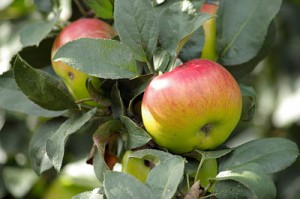 2 medium apples cut into small chunks
2 medium apples cut into small chunks
2 Tbl coconut oil
2 tsp honey
½ cup Walnuts, pecans, or other favorite nuts
1 tsp cinnamon
½ tsp nutmeg
Pinch of sea salt
½ cup coconut curls (very large flakes)
Pre-heat oven to 375° F. This is a small enough batch to fit easily in a toaster oven, which means less energy used and faster cooking.
Toss apple chunks with oil, honey, and spices, including salt. The oil does not have to be melted first, but make sure it is decently mixed in.
Place in a glass baking dish. I often increase this recipe slightly, using 3 medium apples and increasing other ingredients accordingly. For a 3 apple-sized batch, an 8 x 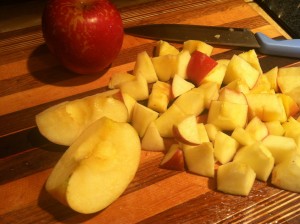 8 Pyrex dish is perfect. It is just the right size to allow the apple juices to build up and enhance flavor and texture.
8 Pyrex dish is perfect. It is just the right size to allow the apple juices to build up and enhance flavor and texture.
Bake 30-45 minutes or until very tender. Add walnuts and coconut curls and bake about 5 minutes longer. The coconut curls will be lightly toasted. 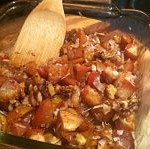
Great served warm or cold. This can certainly stand alone or be served with a good quality creamy addition—Strauss Organic maple, plain or vanilla yogurt, Larry and Luna’s Coconut Bliss in Naked or Vanilla Island, or home-made cashew cream.
Decadent Pumpkin Pudding Cups:
I love this dessert—probably because I made up the recipes using some of my favorite foods. It makes an elegant dessert in individual ramekins (small single-serving baking dishes). Like the above recipe, it takes advantage of the natural sweetness of whole food and combines it with a more healthful natural sweetener. In this case, winter squash is the star. My favorite squash to use is not actually a pumpkin, but rather kabocha squash or a combination of several thick-skinned winter beauties. Butternut makes a great compliment to kabocha. Garnet yams can also be used. Depending on your sweet tooth, the amount of maple syrup can be reduced to 1/3 cup.
“Crust”
1 Tbl coconut oil
6 Medjool dates pitted and roughly chopped
½ cups walnuts, pecans, or hazelnuts
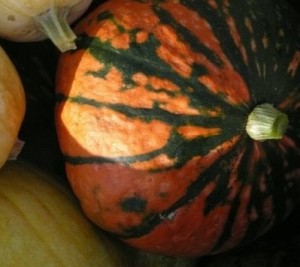 Filling:
Filling:
2 cups of baked winter squash
1 Tbl plus 1 tsp arrowroot powder dissolved in ½ cup maple syrup
1 Tbl fresh grated ginger
1 teaspoon cinnamon
¼ teaspoon sea salt
¼ teaspoon nutmeg
½ teaspoon allspice
1 cup coconut milk
2 tablespoons brandy
1 teaspoon real vanilla extract
Pre-heat over to 350° F.
Thoroughly grea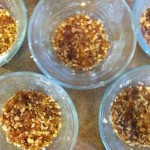 se six 8 oz Pyrex ramekins with coconut oil. Use a food processor to combine walnuts and dates. Pulse chop works well for this. They can also be chopped by hand. The nuts should not be chopped too finely; the consistency of this simple crust should be slightly chunky. Divide date-nut mixture evenly between the ramekins and press into the base of each with your fingertips.
se six 8 oz Pyrex ramekins with coconut oil. Use a food processor to combine walnuts and dates. Pulse chop works well for this. They can also be chopped by hand. The nuts should not be chopped too finely; the consistency of this simple crust should be slightly chunky. Divide date-nut mixture evenly between the ramekins and press into the base of each with your fingertips.
Combine all 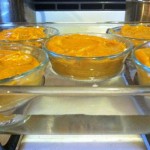 filling ingredients in a food processor and blend together until smooth. Pour pumpkin mixture into ramekins. Place ramekins in a large baking dish and pour 2-3 cups of water into the baking dish so that water reaches at least ½ way up sides of ramekins. Do not get water in ramekins.
filling ingredients in a food processor and blend together until smooth. Pour pumpkin mixture into ramekins. Place ramekins in a large baking dish and pour 2-3 cups of water into the baking dish so that water reaches at least ½ way up sides of ramekins. Do not get water in ramekins.
Bake at 350° F for about 45 minutes. Carefully remove ramekins from water and place them on a wire rack. Cool at least 20 minutes before enjoying. Can be made one or two days in advance. Store in fridge. Time brings out the deeper flavor but the molten texture and intense maple sweetness from the first bake are also irresistible.
Canned Foods and BPA: Native Forest is my preferred brand of coconut milk. Although a little more expensive, it is the only BPA-free canned coconut milk on the market. BPA is found in the lining of most canned goods; the only exceptions I know of are Native Forest and Eden Organics. BPA is an endocrine disruptor and has been shown to mimic estrogen in the body. In animal studies, it has been linked to breast cancer, prostate cancer, altered menstrual cycles, and diabetes. It is best to avoid items with BPA whenever possible.
For the purposes of this recipe, do not use the coconut milk sold in cartons as milk substitutes. It will be too thin. We are going for creaminess and decadence here.
Healthy Choices for Cooking Oils: Coconut milk and oil are gaining popularity as healthy fats. They provide beneficial medium-chain fatty acids, MCFs. MCFs are amazing brain food. There is evidence showing that they are highly beneficial for a range of neurological conditions from Alzheimer’s to epilepsy. The cells lining your gut will love them as well as your brain cells—this makes coconut oil an excellent food for individuals with ADD/ADHD. The best choice food-grade coconut oil is both unrefined and organic. It can be pricey to buy in the grocery store or natural food market, especially when you use it in the quantity that I do. Fortunately, there are many deals online for buying coconut oil in bulk. I have been known to buy five-gallon buckets and divide it with friends. This brings the price down to nearly half of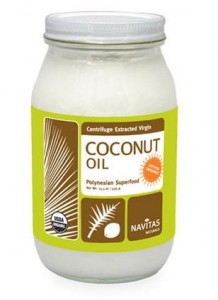 what it is in stores. Hummingbird Wholesale, Mountain Rose Herbs, and Wilderness Family Naturals are all companies I have ordered from depending on the prices being offered at the time of purchase. Coconut oil makes an ideal cooking oil; it is one of the few plant oils that remain stable when heat is applied. Stability means that the oil does not go rancid or change structure easily. Fats/oils are important to the structure of every cell in your body. The food you eat becomes incorporated into your cells. You do not want the fats/oils in your cells to be rancid or have an altered structure. This will lead to dysfunction in your cells, leading to dysfunction in tissues and organs. You cannot have optimal health when there is dysfunction at a cellular level.
what it is in stores. Hummingbird Wholesale, Mountain Rose Herbs, and Wilderness Family Naturals are all companies I have ordered from depending on the prices being offered at the time of purchase. Coconut oil makes an ideal cooking oil; it is one of the few plant oils that remain stable when heat is applied. Stability means that the oil does not go rancid or change structure easily. Fats/oils are important to the structure of every cell in your body. The food you eat becomes incorporated into your cells. You do not want the fats/oils in your cells to be rancid or have an altered structure. This will lead to dysfunction in your cells, leading to dysfunction in tissues and organs. You cannot have optimal health when there is dysfunction at a cellular level.
Oils, Inflammation, and Chronic Disease: Rancid oils can also create inflammation in your body; inflammation is an underlying component of most chronic diseases and sources should be minimized. Making smart decisions regarding the fats and oils you consume is an easy way to minimize sources of inflammation. Unfortunately, the vegetable oils commonly used for cooking are rancid before you even get them home. Picture the cooking oil section of your supermarket. Think of those shelves of oils in see-through plastic bottles. Most of these oils are already rancid because of the high heat extraction process they undergo during processing. Then they sit on the shelf exposed to light that will degrade them further while potentially soaking up who-knows-what from the plastic bottles. Yuck. Not to mention that most canola oil, even organic, is GMO because of crop contamination. If you do nothing else after this post, please open your cupboard and throw these bottles out. Next time you are at the grocery store, fill your cart with extra-virgin cold-pressed olive oil in dark glass jars, cold-pressed grape seed oil, unrefined coconut, oil, CSPO certified sustainable red palm oil, and organic butter, preferably from pasture-raised cows. Organic Valley makes a lovely butter that fits this description. The olive oil should only be used for dishes where it is not heated or for sautéing on very low heat. All the rest can be used for high heat cooking. Sure, these are more expensive than the large bottles of canola and safflower oil but when you purchase them, know that you are investing in your health and your family’s. Buying healthy, nutrient-dense foods is a much better investment than multivitamins, exotic superfoods, supplements, and pharmaceutical drugs.
 I started writing this post in the spirit of sharing these two yummy recipes. While writing it, I let myself follow the flow of thoughts and information. So, thanks for bearing with a post that rambles a bit and touches on all sorts of topics! Please post a comment or question if there is an area you would like more information on. Also, please let me know how these recipes turn out for you! Happy Healthy Holidays.
I started writing this post in the spirit of sharing these two yummy recipes. While writing it, I let myself follow the flow of thoughts and information. So, thanks for bearing with a post that rambles a bit and touches on all sorts of topics! Please post a comment or question if there is an area you would like more information on. Also, please let me know how these recipes turn out for you! Happy Healthy Holidays.
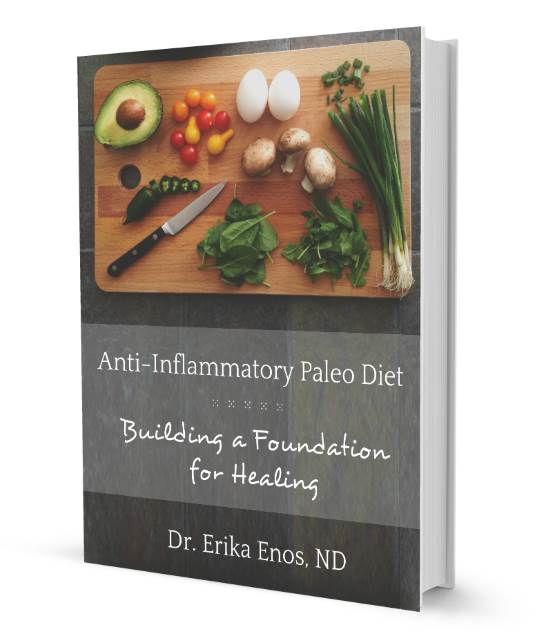
Pingback: Contact - Naturopath - Portland, Merced | Dr. Erika Enos, N.D. - Healing Roots Naturopathic
Pingback: Holiday Sickness Prevention with Dr. Erika Enos | Fresh Fuzz Denver